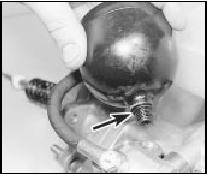Hydraulic unit accumulator (ABS) - removal and refitting
Note: A new O-ring must be used between the accumulator and the hydraulic unit on refitting.
Caution: Refer to the
precautions in Section 1.
Removal
1 Disconnect the battery negative lead.
2 Depressurise the hydraulic system by pumping the brake pedal at least 20 times, or until it becomes hard.
3 Wrap a clean rag round the base of the accumulator to catch any spilt fluid.
4 Unscrew the accumulator using a hexagon key. Remove the accumulator, noting the sealing ring and being prepared for fluid spillage (see illustration). If fluid is accidentally spilt on the paintwork, wash off immediately with cold water.

17.4 Unscrew the accumulator and remove it, noting the O-ring (arrowed)
Refitting
5 Fit a new O-ring to the base of the
accumulator, fit the accumulator and tighten
it.
6 Reconnect the battery. Switch on the ignition and check that the hydraulic unit pump stops within 60 seconds; if not, the accumulator is likely to be faulty.
7 On completion, bleed the complete hydraulic system and check for leaks around all disturbed components.
See also:
Distributor - removal and refitting
Contact breaker ignition system
OHV engines
Removal
1 Disconnect the leads from the spark plugs,
spring back the retaining clips and lift off the
distributor cap.
2 Disconnect the LT lead at the ...
Speed control (if equipped)
With speed control set, you can maintain a speed of 48 km/h (30 mph)
or more without keeping your foot on the pedal. Speed control does not
work at speeds below 48 km/h (30 mph).
Do not use the spe ...
Crankshaft rear oil seal - renewal
1 Remove the flywheel/driveplate.
2 Prise out the oil seal. If necessary, drill the
outer face of the oil seal and use self-tapping
screws and a pair of grips to withdraw the
seal (see illustratio ...
